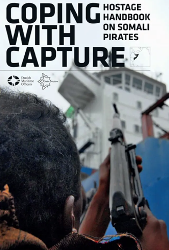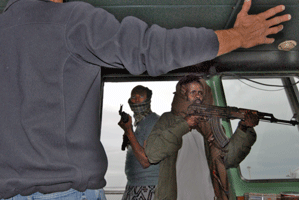 Pirates and Privateers Pirates and Privateers
The History of Maritime
Piracy
Cindy Vallar, Editor
& Reviewer
P.O. Box 425,
Keller, TX 76244-0425
    
Books for Adults ~ Pirate Captives

Coping with Capture: Hostage
Handbook on Somali Pirates
Danish Maritime Officers, 2012, ISBN 978-87-995053-0-2,
US $35.00
    
In the
first foreword of this book, Captain Andrey Nozhkin
writes, “Nobody is immune to misfortune.” He knows
whereof he speaks, for he spent sixty-eight days in
captivity after Somali pirates seized the CEC Future
on 7 November 2008. For ships traveling in the
waters between the east coast of Africa and the
Middle East, piracy has become such a threat that
the question isn’t if they will be attacked but
when. A number of books have been published in
recent years on Somali pirates, but none of them
address what seafarers need to know should they face
such an attack and find themselves hostages of the
pirates. Coping with Capture fills that
void.
The opening paragraph of the Introduction explains
the purpose of this book.
The aim of
this handbook is to better prepare seafarers for
encounters with Somali pirates and to assist
them through a hostage situation with as little
mental and physical injury as possible.
While no handbook can
guarantee total protection, this volume provides
hands-on, real-life techniques for seafarers to
endure and survive captivity and helpful guidelines
for their families to cope with their loved ones’
internment at the hands of Somali pirates. In 2009,
a hostage spends an average of fifty-five days in
captivity while the pirates negotiate with the
shipping company. A year later, that time has
doubled, and in 2011, seamen often find themselves
captive for five months. These are averages; the
Chandlers spend 388 days as hostages, and the crew
of MV Iceberg, which i taken in March 2010,
remain hostages as of February 2012.
The book opens with a succinct overview of these
criminals, who range in age from twelve to forty,
and how the hierarchy in which they operate works.
Also covered are how attacks unfold, who’s who among
the pirates, the initial period of captivity, and
life for a hostage on the ship and on land. Even if
a vessel has a citadel or a safe room for the crew
to withdraw to in the case of a successful attack,
the authors point out the pros and cons of having
these sanctuaries. Other topics include what to do
in case of illness or injury, how to survive
mentally and physically, which pirates to interact
with and how to interact with them, and which
pirates to avoid. Cultural awareness and naval
intervention are considered as well.
Another key component of Coping with Capture
concerns the negotiation process and why it’s
important to follow certain procedures. Torture is
also discussed, both from the aspect of its use on
hostages and how these seafarers can cope with and
counter the use of terror. The final sections of the
book address "Ransom and Release," and "The Family."
The appendices are equally important, for they
provide visual and descriptive information on pirate
vessels and their weaponry, websites to visit for
additional information on pirates, protection
against attack, and organizations involved in
shipping and security, as well as five pages of
vocabulary, in English and Somali, to help readers
learn to communicate.
It is evident from reading Coping with Capture
that a lot of research and thought goes into the
writing of this handbook. The team of authors
includes military linguists, instructors in hostage
survival and counter-piracy, a cultural expert from
Somalia, a military crisis psychologist, and members
of Naval Special Forces.
The price of the book may give some people pause,
but the wealth of hands-on information with generous
inclusion of color photographs to reinforce the
text, and the inclusion of highlighted boxes of key
points and guidelines to follow, make Coping
with Capture a valuable resource for any
seafarer, commercial or private, who is considering
venturing into the dangerous waters in the region
around the Horn of Africa. Some suggestions will
prove valuable in any situation, even though the
focus is on Somali pirates. Coping with Capture
should also be essential reading for seafaring
families so they better understand what their loved
ones face and why time plays a crucial role in
securing their release. This handbook is an
excellent resource for those seeking more
information on how Somali pirates operate and what
hostages face.
Armed pirates
entering the bridge and taking control
of the vessel.
 The
initial time until the pirates have gained
control with the crew is the most
dangerous, as the pirates are highly
stressed and prone to very aggressive
behavior. They fear interference from the
naval forces and crewmembers fighting back
or resisting the takeover. The pirates
enter the bridge, from the bridge wing.
They have climbed the outside stairs to
the bridge, and enter shouting and aiming
their weapons at the personnel inside.
They sometimes fire their AK-47’s through
the door before entering to make sure the
crewmen inside are subdued and ready to
surrender. Quite a few vessel captains
have been apprehended on the bridge,
intent on outmaneuvering the attackers,
and not having evacuated to the safe room
in time. Other crewmen report leaving the
bridge as the pirates are entering from
the bridge wing. Running down the stair to
the safe room with the pirates on their
heels and having to push against the safe
room door to close it, with the pirates
pushing from the other side. The
initial time until the pirates have gained
control with the crew is the most
dangerous, as the pirates are highly
stressed and prone to very aggressive
behavior. They fear interference from the
naval forces and crewmembers fighting back
or resisting the takeover. The pirates
enter the bridge, from the bridge wing.
They have climbed the outside stairs to
the bridge, and enter shouting and aiming
their weapons at the personnel inside.
They sometimes fire their AK-47’s through
the door before entering to make sure the
crewmen inside are subdued and ready to
surrender. Quite a few vessel captains
have been apprehended on the bridge,
intent on outmaneuvering the attackers,
and not having evacuated to the safe room
in time. Other crewmen report leaving the
bridge as the pirates are entering from
the bridge wing. Running down the stair to
the safe room with the pirates on their
heels and having to push against the safe
room door to close it, with the pirates
pushing from the other side.
|
|
Hostage
guarded by two pirates from the holding
team.
 There
will often be pirates present in the cabin
where the crew members are confined. The
crew are forbidden to leave the room
unescorted not even to use the toilet. The
guards chew khat and are in general a
nuisance to the confined crew. They can be
very noisy, talking or arguing loudly or
playing music on their radios all through
the night, making rest or sleep very
difficult for the crew. Their main
interest in the crew members concern the
crews’ personal items and knowledge about
possible hidden valuables. They will often
loot the rooms on the ship, in their
search for things to take ashore and sell
at the local market for a small profit.
Stealing may be frowned upon by the
holding team leader, so the lower ranking
guards may try to hide the stolen items
from their leader. They often adopt a
strategy of asking the hostage to give a
personal item as a gift or pressure him
into exchanging an item, like his watch,
for an old and broken one. They use their
mobile phones constantly, even to speak to
other guards on-board the ship and often
take a particular interest in pornographic
material present onboard. The nearly
constant presence of the guards is a
strain on the confined crew. There
will often be pirates present in the cabin
where the crew members are confined. The
crew are forbidden to leave the room
unescorted not even to use the toilet. The
guards chew khat and are in general a
nuisance to the confined crew. They can be
very noisy, talking or arguing loudly or
playing music on their radios all through
the night, making rest or sleep very
difficult for the crew. Their main
interest in the crew members concern the
crews’ personal items and knowledge about
possible hidden valuables. They will often
loot the rooms on the ship, in their
search for things to take ashore and sell
at the local market for a small profit.
Stealing may be frowned upon by the
holding team leader, so the lower ranking
guards may try to hide the stolen items
from their leader. They often adopt a
strategy of asking the hostage to give a
personal item as a gift or pressure him
into exchanging an item, like his watch,
for an old and broken one. They use their
mobile phones constantly, even to speak to
other guards on-board the ship and often
take a particular interest in pornographic
material present onboard. The nearly
constant presence of the guards is a
strain on the confined crew. |
(Source:
Photos, reconstruction by Citadel Solution, used
with publisher's permission)
Review
Copyright ©2012 Cindy Vallar

Click to contact me
Background image compliments
of Anke's Graphics |

 The
initial time until the pirates have gained
control with the crew is the most
dangerous, as the pirates are highly
stressed and prone to very aggressive
behavior. They fear interference from the
naval forces and crewmembers fighting back
or resisting the takeover. The pirates
enter the bridge, from the bridge wing.
They have climbed the outside stairs to
the bridge, and enter shouting and aiming
their weapons at the personnel inside.
They sometimes fire their AK-47’s through
the door before entering to make sure the
crewmen inside are subdued and ready to
surrender. Quite a few vessel captains
have been apprehended on the bridge,
intent on outmaneuvering the attackers,
and not having evacuated to the safe room
in time. Other crewmen report leaving the
bridge as the pirates are entering from
the bridge wing. Running down the stair to
the safe room with the pirates on their
heels and having to push against the safe
room door to close it, with the pirates
pushing from the other side.
The
initial time until the pirates have gained
control with the crew is the most
dangerous, as the pirates are highly
stressed and prone to very aggressive
behavior. They fear interference from the
naval forces and crewmembers fighting back
or resisting the takeover. The pirates
enter the bridge, from the bridge wing.
They have climbed the outside stairs to
the bridge, and enter shouting and aiming
their weapons at the personnel inside.
They sometimes fire their AK-47’s through
the door before entering to make sure the
crewmen inside are subdued and ready to
surrender. Quite a few vessel captains
have been apprehended on the bridge,
intent on outmaneuvering the attackers,
and not having evacuated to the safe room
in time. Other crewmen report leaving the
bridge as the pirates are entering from
the bridge wing. Running down the stair to
the safe room with the pirates on their
heels and having to push against the safe
room door to close it, with the pirates
pushing from the other side. There
will often be pirates present in the cabin
where the crew members are confined. The
crew are forbidden to leave the room
unescorted not even to use the toilet. The
guards chew khat and are in general a
nuisance to the confined crew. They can be
very noisy, talking or arguing loudly or
playing music on their radios all through
the night, making rest or sleep very
difficult for the crew. Their main
interest in the crew members concern the
crews’ personal items and knowledge about
possible hidden valuables. They will often
loot the rooms on the ship, in their
search for things to take ashore and sell
at the local market for a small profit.
Stealing may be frowned upon by the
holding team leader, so the lower ranking
guards may try to hide the stolen items
from their leader. They often adopt a
strategy of asking the hostage to give a
personal item as a gift or pressure him
into exchanging an item, like his watch,
for an old and broken one. They use their
mobile phones constantly, even to speak to
other guards on-board the ship and often
take a particular interest in pornographic
material present onboard. The nearly
constant presence of the guards is a
strain on the confined crew.
There
will often be pirates present in the cabin
where the crew members are confined. The
crew are forbidden to leave the room
unescorted not even to use the toilet. The
guards chew khat and are in general a
nuisance to the confined crew. They can be
very noisy, talking or arguing loudly or
playing music on their radios all through
the night, making rest or sleep very
difficult for the crew. Their main
interest in the crew members concern the
crews’ personal items and knowledge about
possible hidden valuables. They will often
loot the rooms on the ship, in their
search for things to take ashore and sell
at the local market for a small profit.
Stealing may be frowned upon by the
holding team leader, so the lower ranking
guards may try to hide the stolen items
from their leader. They often adopt a
strategy of asking the hostage to give a
personal item as a gift or pressure him
into exchanging an item, like his watch,
for an old and broken one. They use their
mobile phones constantly, even to speak to
other guards on-board the ship and often
take a particular interest in pornographic
material present onboard. The nearly
constant presence of the guards is a
strain on the confined crew.